Carpet
The carpeting in your home was laid by a professional installer as prescribed by the manufacturer. While wear is inevitable, there are some steps you can take to care for your carpet so you can enjoy it for years to come. Proper care is quick, easy and inexpensive.
– Relocate furniture periodically to allow for even distribution of wear.
– Vacuum frequently
– Clean up spills promptly
Maintenance Tip: Vacuuming will remove loose fibers from carpet yarns. You may see a high volume of loose fibers after moving in. This is normal with new carpet and should lessen with time depending on how often you vacuum.
Seams in the carpets are unavoidable, as carpet is manufactured in roll widths which are normally less than the width of a room. As time goes by, carpet fibers relax and seams, which may be more noticeable when new, become less noticeable with time.
Safety Tip: Chemicals and carpets are a bad combination. Here are some culprits:
– Acne medicines
– Acne bleaches
– DMSO muscular-ache medication
– Household cleaners
– Insecticides and pesticides
– Plant food
Once a chemical stain is visible on your carpet, the damage is done and the carpet will likely need restoration or replacement. If you know that one of these chemicals has come in contact with your carpet, utilize a professional carpet cleaner as soon as possible.
Hardwood
Hardwood flooring is an investment that, with proper care, will last for years to come. Familiarize yourself with the hardwood flooring manufacturer’s care and maintenance recommendations. Often manufacturers advertise specific products to clean and care for hardwood or manufactured flooring.
– Wipe up spills immediately. Standing water is the enemy of hardwood; NEVER wet mop hardwood. Always thoroughly dry if using a damp cloth to clean.
– Clean dirt and grit frequently. Small particles can act like sandpaper and can damage the finish on your hardwood floor.
– Control environmental conditions: Ideal interior temperature is 68-72 degrees and 40-60 percent humidity.
– Vacuum with a brush attachment; don’t vacuum with a beater bar.
– Lift furniture to move; do not drag across the floor.
– Be aware that high heels can dent a hardwood floor.
– Direct sun can discolor your hardwood floor. Use curtains or blinds to protect flooring from the sun’s intense UV rays.
– Maintain adequate air circulation and ventilation; excessive heat or dryness can result in gapping and splitting, and excessive humidity can result in cupping.
– Hardwood flooring is a natural material that expands and contracts slightly in response to seasonal changes. Minor gaps are to be expected.
Tile
Tile countertops are durable and with reasonable care, will give you years of good service. As a preventative measure you may wish to apply a grout sealer to the countertop to reduce the chance of discoloration. This sealant product is available at most hardware stores and should be applied soon after you move in.
Ceramic tile grout is subject to cracking with the slightest shrinkage of lumber, and it is inevitable that this will occur during the first year. Check grout and caulking every six months and touch up as needed.
Tub and shower tile may also develop separations where vertical and horizontal surfaces meet at 90-degree angles, and where tile meets plastic, fiberglass or other material. This separation is natural and is caused by expansion and contraction of various materials.
It is extremely important that you re-caulk these areas when separation occurs to prevent water damage to surrounding areas, walls and cabinets. Seal any separation or gap that could let water travel and cause possible damage. Caulking that contains silicone works best where water is present.
Maintenance Tip: Caulk naturally shrinks with time and requires replacement. All caulking is considered homeowner maintenance.




